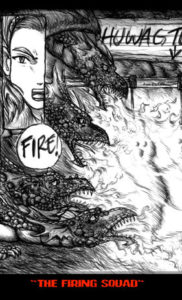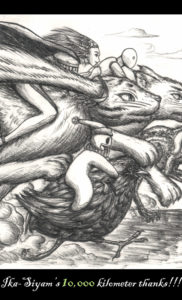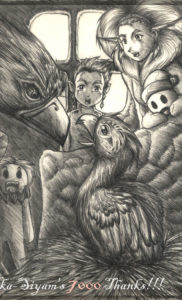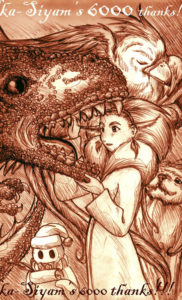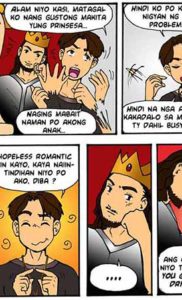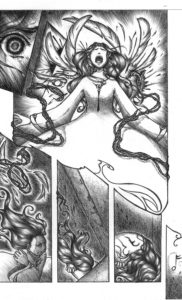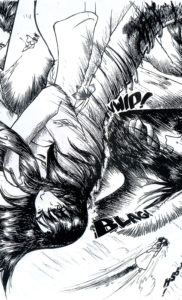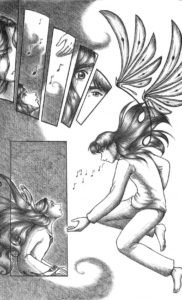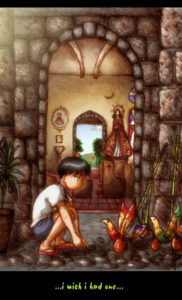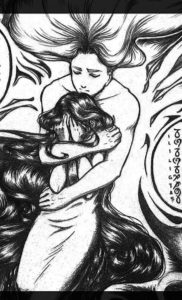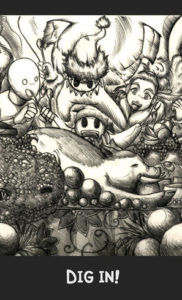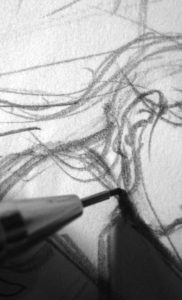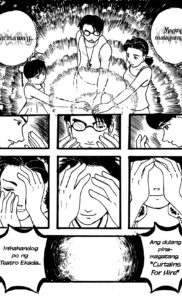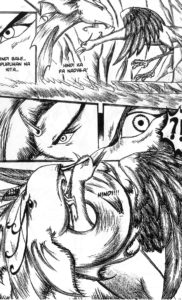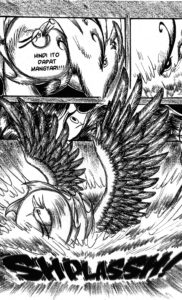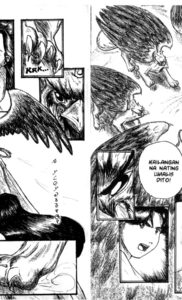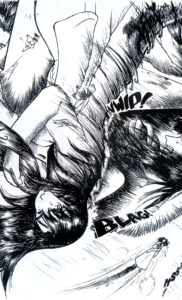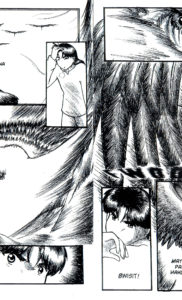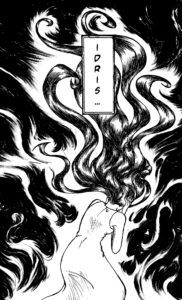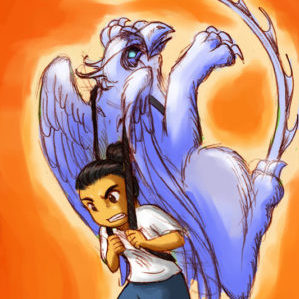 Joanah Tinio-Calingo graduated from the Universityof the Philippines, College of Fine Arts. A member of the independent komiks group, Point Zero, she is the creator of the Cresci Prophecies, and the co-creator of Kanto Inc. (which she works on together with her husband, Melvin). Her works have been displayed in the Jorge Vargas Museum, and the Musibitsuki Exhibit, organized by the Metropolitan Museum of Manila. She has also helped create two animated short films, “Pangitain” and “Blind Beauty”, the latter of which also received recognition in the alternative film awards at the Gawad CCP
Joanah Tinio-Calingo graduated from the Universityof the Philippines, College of Fine Arts. A member of the independent komiks group, Point Zero, she is the creator of the Cresci Prophecies, and the co-creator of Kanto Inc. (which she works on together with her husband, Melvin). Her works have been displayed in the Jorge Vargas Museum, and the Musibitsuki Exhibit, organized by the Metropolitan Museum of Manila. She has also helped create two animated short films, “Pangitain” and “Blind Beauty”, the latter of which also received recognition in the alternative film awards at the Gawad CCP
Q: Everyone has an origin story. Could you share with us the exact moment (or moments) wherein you realized that you wanted to become an artist?
When I was a kid, I used to draw animals a lot. At one point I wanted to become a Veterinarian.
I had a lot of pets. Miniature parrots, a couple of dogs, a few ducks, chickens, aquarium fish, even a couple of Martinez birds. I remembered drawing my pets’ portraits in a notebook, imagining they had professions. And then underneath their portrait was a description of their profession, and their name. I guess I was imagining they had another life in my head, and that’s what probably started my writing stories. I used to bookmark all the animal pictures in our encyclopedia (Funk and Wagnalls, if I remember correctly), and drew them whenever I felt like it.
In High school, I liked watching Disney films (and other animated films), and I wanted to become a Disney animator. I was a collector of anything Disney. Sometime after watching Pocahontas and The Swan Princess, I started writing my first novel, Within a Mon-ster’s Eye. It was a fairy tale about a Princess that was kidnapped by a dragon, that had killed her prince. Back then, my only exposure to comics were a few borrowed books (borrowed by my sister), specifically Sandman: Season of Mists, and Death of Superman, a few issues of Disney’s Aladdin, comic adaptations of other Disney movies, Pugad Baboy, and Nonoy Marcelo’s Ikabod. But I had no interest in making comics then.
But, when I was in 3rd year high school, my classmates started talking about Sailormoon. I had no idea what that was. I just remembered checking it out one time, and I found the body proportions ridiculous!
The story, however, was really interesting. I started watching it in the middle of the first season (airing on Ch. 5), and it got me hooked to the point of looking for cheap collectibles (like teks, and stickers). It was only then that I discovered the Chinese print of the Sailormoon comic series. I didn’t they were called manga. I even thought they were knock-offs of the TV series! Back then, there were no scanlations; but a few dedicated fans translated the series in novel form! (Thank you internet!) It shocked me too, to see a suicide scene in a comic!
I realized that there were other Japanese comics, all printed in black and white. The art was amazing even without color! My school library also had a Japanese magazine (translated in English), that happened to have a feature about manga (it’s influence on the readers, the titles that were hot then, and why they clicked with readers). It was an eye-opener, and it also introduced me to CLAMP’s Magic Knight Rayearth. The art was unlike anything I’ve seen!
I took up Fine arts in UP, and I found friends who were also into manga and anime. They wanted to make their own “manga”, and I joined in. The rest is history.
Q: From that moment, and throughout your journey as an artist, what has been your biggest struggle?
The real struggle came when I started making Cresci Prophecies (my first comic). I know I’m not that good. Compared to my idols and my peers (classmates), my art sucked.
I spent years developing my story, but my art was ugly. That didn’t stop me from doing drafts. It was okay then, because only my friends were reading my work.
When I met the Point Zero group during animation class, I mustered up the courage to try and join them. Not only join the group, but sell my own comic, too. They’d been selling their titles for a while, and I wasn’t sure if my work was good enough to be sold.
I sold one copy.
Photocopy shops, at the time, were rejecting my comic, simply because the art was too black. I was a little desperate. You could say this was a recurring problem. Over the years, I’ve been looking for shops that could properly reproduce my traditionally ren-dered comic (ink and crayon).
Twelve issues into it, It was getting difficult for me to sell my comic. My enthusiasm dwindled a bit. I got discouraged. But I’m hard-headed, and so I continued doing it anyway.
There was one time I attended a comic forum (called Paskom, or Pasko ng Komiks in 2007), and I was one of the panelists. I was with fellow female comic artists, and we discussed how hard it was to sustain this comic-making lifestyle. When women start to have families, they have less time to spend on non-family related work. I wanted to challenge that. I set my mind to still work on my comic, despite that fact. And it IS difficult.
I continued doing comics during my pregnancy (up to my 7th month). My hands were aching. Para akong may rayuma. [It’s like I had rheuma.] But I managed to finish a couple of chapters. I was really determined to release the new book the following year.
It’s also hard to work with a toddler. I could only work during his naptime! It’s hard to be a comic-creating Mom.
To sum that up, I struggle with time, resources, and being able to sustain my enthusiasm.
Q: How have you been able to cope with (or overcome) this struggle?
Over the course of 15 years, Cresci Prophecies got some dedicated fans and readers. I was really surprised to meet people who really liked the story. So despite the lack of skill on my part, the story seemed to hook them. I wanted to give up around issue 12, but I suddenly got good feedback. They were few, but really encouraging. They really helped boost my ego (haha!). And I really needed to know I was doing something right. It felt so good.
Technology became better, and I no longer have problems finding shops that can print my work. Plus, we have printers at home that could do whatever I need them to do.
As for allotting time and energy, I set a schedule to meet deadlines. Every day (actually 4 times a week), I set a couple of hours to work on the comic. I need to follow it religiously or else I’d fall behind. I’ve also developed an inking process that helps me finish as many pages as I can, the fastest way I can, and sustain my enthusiasm as long as possible before burn-out happens.
Since I can only make comics whenever my son is asleep, I needed to speed up my drawing. I eventually called it “Ninja-comic-making” (making pages as fast, as accurately, and as quietly as possible). You learn to do that when you can’t make any noise. ^_^
Q: What would you consider is the ONE thing that REALLY helped you level up your skills?
We’ll go way back on this one.
My sister is a good artist. Far better than me. She was skilled with colored pencils, and she learned different inking techniques, because her course (Architecture) required her to render objects as realistically as possible.
I picked up techniques from her. I practiced them, back when I was still in high school, but unlike her, I didn’t attend art workshops. She had a lot of art books, so I had the same exposure. I knew what was tasteful, and what wasn’t. I got that from her.
I remember when I was in grade school, we had this art assignment where we needed to draw different landforms. I rendered each and every rock with line shading. I thought it was unusual, but I was pretty obsessed with it. I carry that technique until now. Also, we had a guitar string business back then, and I helped out. There was this contraption I had to work with that required my hands to be steady, and that developed my wrist control. If you’re familiar with how I shade my heavy sketches, that was the result of years of training. My current art style came from all that combined.
Q: What is one thing you’d wish you’d known before you started your artistic career? Why?
That you needed a ton of patience, funds, and the will to pursue it.
Let’s face it. When we make art that’s intended to get a particular reaction from people, you have to embrace whatever reaction you get from them. It’s a make or break thing. They won’t always love your work, and if they don’t like your work, they won’t ask for more.
And, if they don’t ask for more, you can’t earn from it. And if they don’t like it, it’s also a punch in the face… Sort of.
Parang pakapalan na lang ng mukha. Kailangan matigas ang ulo mo para tumagal. At kailangan din marunong kang tumanggap ng payo sa iba, at harapin o baguhin kung anong mali sa gawa mo, nang hindi sumusuko.
[It’s just a matter of having thick skin. You have to be stubborn to survive. And you also need to learn to accept the advice of others, and face or change whatever is wrong with your work, while not giving up.]You won’t know that until you experience making, and selling your work. Pros will tell you to keep on drawing. Keep on drawing despite everything. And by “everything”, they meant anything life hurls at you.
Q: What drives or inspires you to continue making art or comics?
Sometimes you want to give up. I wanted to give up. But then I thought, “I’ve been making this for a while now, and I have readers. If I stop without finishing what I started, then I might have wasted my reader’s time. I don’t want my favorite authors to do that to me either.”
So kapit lang. [Just hold on.]
It’s not really the obligation of needing to finish a work. It has something to do with the years of effort spent on your part. I’ve worked on it for a long time. I like my story, and I want to see it finished. It may be a foolish endeavor to some. But for a writer and artist to actually visualize something, put it on paper, show it to the world, and have the world appreciate it… It’s a feeling I can’t simply write here. It’s quite fulfilling.
It’s like cooking a complicated recipe and have your family love it. It makes the effort worthwhile.
Q: What does your average day look like? (And when do you fit in the time to create art?)
I start my day around 6 am, and do my normal house chores (cooking, cleaning, prepping my kid’s milk for the day, bathing my toddler, etc). My morning is crazy up until about 11 am.
Most of my early afternoon is spent watching over my son, taking care of personal stuff (like eating, taking a bath, checking messages on Facebook, and cleaning up after my toddler, and maintaining order around the house).
When my son sleeps around 3 P.M., that’s my ME time. “Me time” is when I can play games. I can take a nap, or work on my personal projects. I just choose to do one of those (I usually leave out sleeping). Lately, I’ve been working on my new issue. I work on that around a couple of hours, or until my son wakes up.
I go back to house chores. A little before my son’s bedtime, we watch anime or some other TV show. Then I finish the remaining house chores. I end my day with Sailor Drops (Sailormoon puzzle game), if I still have energy or time to spare, then sleep around Mid-night.
Q: How do you deal with distractions or challenges that you encounter while you’re working on your art?
My only distraction is gaming. 😛 I resist playing just before working. I keep reminding myself that my kid might wake up anytime, so I have to work quickly!
I consider comic-making as my distraction. I just focus on my work for just short while. I have a whole day to face everything else anyway.
I also listen to music to keep my concentration.
Q: What do you do when you feel just completely uninspired or burnt out? How do you motivate your-self to start working again?
When I started making my comics, I found out that I have artistic phases. I usually work on my projects for 2-3 months straight. After that I get burnt out. I stop doing anything comic-related for about a month or so. It always happens.
So what I do is, I read and watch new stuff, look at art books, look at anything that could inspire me again, or feed my mind with new info. When I discover a new story, or a new artist that’s really good, it gets me going.
I usually write first. When I need to work on a new Kanto Inc. draft (after brainstorming with Melvin), I write until I finish it. In the case of CP, I go over my notes, and then I work on the comic drafts for future issues (CP studies are around 5 issues ahead of the current chapter), and then I get excited to work on it. After that I’d be ready again to work on the next issue.
Before I had my son, I make 2-4 issues (chapters) a year, with that kind of cycle.
Q: What would you say has been your most EPIC win so far?
Hard to pick one, but…
When we got awards (including first prize) and a few recognitions for Pangitain, an animated short that was based on Cresci Prophecies. It was a college project, but the film got 3 awards from 3 different competitions, including Gawad CCP. It was shown in independent international film festivals, too. The film also got featured as a Daily Deviation on Deviantart.com. That, for me, was the icing on the cake.
That, and an anonymous Wiki Pilipinas article where Cresci Prophecies got included as one of the 10 Indie Komiks titles you need to read before you die (made mid 2000’s). I have no idea who wrote it, but I giggled… Whoever you are, thanks!
Q: What would you say has been your biggest failure?
Balancing my time, not having enough patience, and not having to try different techniques.
I didn’t make time to study coloring before. I can color, but I know I can do better. I haven’t tried toning my work on my own (I’m a slow learner), or studying other digital software that could improve my work. I suck at perspective drawing. I didn’t make time to practice. I just dived into comic making, without practicing the basics. I know that it’s a no-no. So huwag niyo akong gayahin, magpraktis kayo! [So, don’t follow my example. Practice!]
Another is balancing my time between work, play, and family. I should fix that right away.
Ah, and TYPO errors. Lagi na lang nagmamadali. [I’m always in a rush.]
Q: What, for you, has been the best way to promote yourself and your work to potential fans, clients, or publishers?
The internet. Conventions. And some dedicated readers.
Facebook fan pages are a big help. You can upload preview pages there, and it gets shared by friends and other readers, too. Deviant art was also a great way to get feedback and new readers.
Conventions give you exposure. As a comic reader, I like reading printed stuff. It’s nice when I get to see the work online, but I love getting the hard copy of the work. I don’t usually look for things to read online, so conventions are a great way to find new titles to read. Also, publishers get a taste of what they can publish in the future, by showing them a printed copy.
Fans tend to share your work to other people. That’s the best way to convince potential readers to try out my stuff.
Q: What has been your game plan throughout your journey? What’s the BIG picture here? The ultimate dream? The end game?
The Ultimate dream? An animated series! Or a play! Haha! for Cresci Prophecies that is.
Seriously, just finishing the project, and tell it in its entirety. Cresci Prophecies has been a big BIG risk for me. I know a lot of independent authors who choose to make short stories because it’s doable with their day jobs and school work. I understand that, and with the nature of irregular releases from indie creators, readers choose to buy finished stories.
I took the challenge of doing a long story, a serialized one, something that paid comic artists do. Sobrang hirap magtuloy-tuloy ng iisang kwento. Matapos ko lang ‘to, masaya na ako. [It’s really hard to continue just one story. If I can just finish this, I’ll be happy.] I have a long way to go.
As for Kanto Inc., we want it to be published one day, and be read by more people. We love working on that project, and hopefully someday more people can read it…. and maybe have its own TV series? Hahahah! :3
Q: What, for you personally, has been the source of your ideas, creativity and talent?
Ideas? Everyday life. Yung mga documentaries, yung mga anecdotes ng mga tao, at mga experiences nila. Minsan din yung weirdness ng mga bagay-bagay. [Those documentaries and anecdotes of people and their experiences. Sometimes, the weirdness of certain things.] I loved watching Ripley’s Believe it or Not! It’s weird and it’s real. ‘Di ba [Isn’t it true that] “Fact is stranger than fiction”? Madaming mahuhugot na ideas from real life. Tapos pwedeng magamit sa fantasy stories. [You can draw a lot of ideas from real life. Then you can use them in fantasy stories.]
Creativity? Fellow artists. I like reading about creative processes. I like watching people work on their pieces. Para sa’kin [For me], the end result is as important as the process that created it. I collect “Disney Art of…” books, just to see how they came up with their designs, and read about the changes that the film went through.
Talent? Genes maybe. My Mom used to write stories, and a few of my uncles paint, and my Dad did a bit of calligraphy (my handwriting sucks, though).
Q: What is your big “WHY”?
I like telling stories. I love creating stories. It would be a waste if they just stayed in my head. I like drawing. I’m not as good as my favorite artists, but I like doing it, no matter how crappy it looks most of the time. Story + Art = COMICS.
Doing it keeps me sane. X3
Quick-Fire Questions
Q: What 3 stories (comics, movies, documentaries, novels, etc.) would you say influenced and inspired your work the most?
Sailormoon, Rayearth, Sandman: Season of Mists.
Q: What are the top books, art books, blogs, podcasts, or workshops you’d recommend that helped you level up your skills?
For podcast: Writing Excuses.
Books: “Art of Disney’s…” Series of books by Hyperion (They’re probably out of print so search them out in Booksale), or any Art of books that show the creative process.
Secret Teachings of a Comic Book Master (Alfredo Alcala).
Specialized How to Draw Manga series (the ones with specific topics, like Couples, casual wear, etc.). Making Comics and Understanding Comics.
I also recommend you guys attend academic talks about comics. It would be nice to understand the medium we chose (if you’re into comics), it’s place in the art field and the history of the art form. If not, read books and documentaries about comic history, of any culture. It’s really eye opening.
Q: If you could work remotely, from anywhere in the world, where would your office be? Why?
Wala, sa bahay lang. Hahaha, tapos may view ng bundok. XD [Nowhere. Just at home. With a view of the mountains.]
Q: Name ONE artist/writer that, if you could, you would pick their brain and find out all the hidden secrets behind their amazing work?
Sydney Sheldon.
Q: Who do you consider your biggest mentor that helped you improve your skills? (Doesn’t have to be someone you’ve met personally.)
Neil Gaiman (met him too, happy day!).

